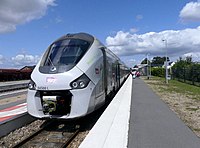
Photo from wikipedia
This paper analyzes the energy and environmental impact of karanja biodiesel fuel from its production to its utilization (farm to fire), using a life‐cycle assessment method, and comparing it with… Click to show full abstract
This paper analyzes the energy and environmental impact of karanja biodiesel fuel from its production to its utilization (farm to fire), using a life‐cycle assessment method, and comparing it with its fossil diesel counterpart. For this purpose, the net energy ratio, the net energy gain, and the equivalent carbon dioxide (CO2) emission reduction are estimated considering the equivalent energy impacts and CO2 emissions of important input and output quantities. The expressions for estimating equivalent CO2 reduction in production to utilization process are obtained by considering the CO2 absorption capacity of the biodiesel plant. The effects of the eutrophication and acidification potential during the life cycle of the crop are also considered. A sensitivity analysis of the most influential parameters on net energy ratio and CO2 emission reduction is conducted. The analysis shows that the biodiesel yield from seeds and the yield of co‐products are the two critical parameters affecting the net energy ratio. Similarly, the equivalent CO2 emission reduction potential of the karanja biodiesel depends primarily on the brake thermal efficiency and energy equivalent CO2 emission of biodiesel fueled engine combustion. A techno‐economic evaluation of the production of karanja biodiesel for different plant sizes and cost‐recovery periods is also made. The economics of the production of karanja biodiesel, considering different plant sizes and cost recovery periods, suggests that the price of biodiesel decreased for a higher capacity biodiesel plant and a longer cost‐recovery period. Beside these factors, the price of feedstock remains a most significant component of cost estimates. © 2021 Society of Chemical Industry and John Wiley & Sons, Ltd
Journal Title: Biofuels
Year Published: 2021
Link to full text (if available)
Share on Social Media: Sign Up to like & get
recommendations!